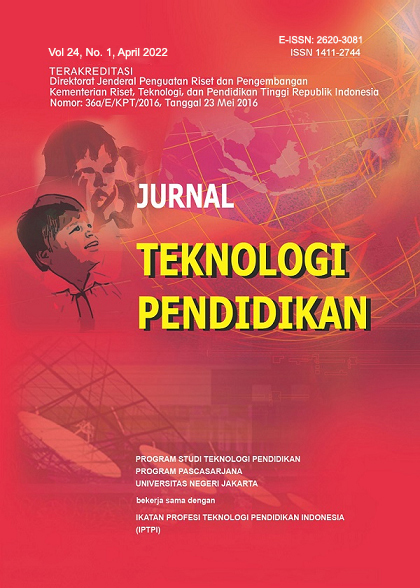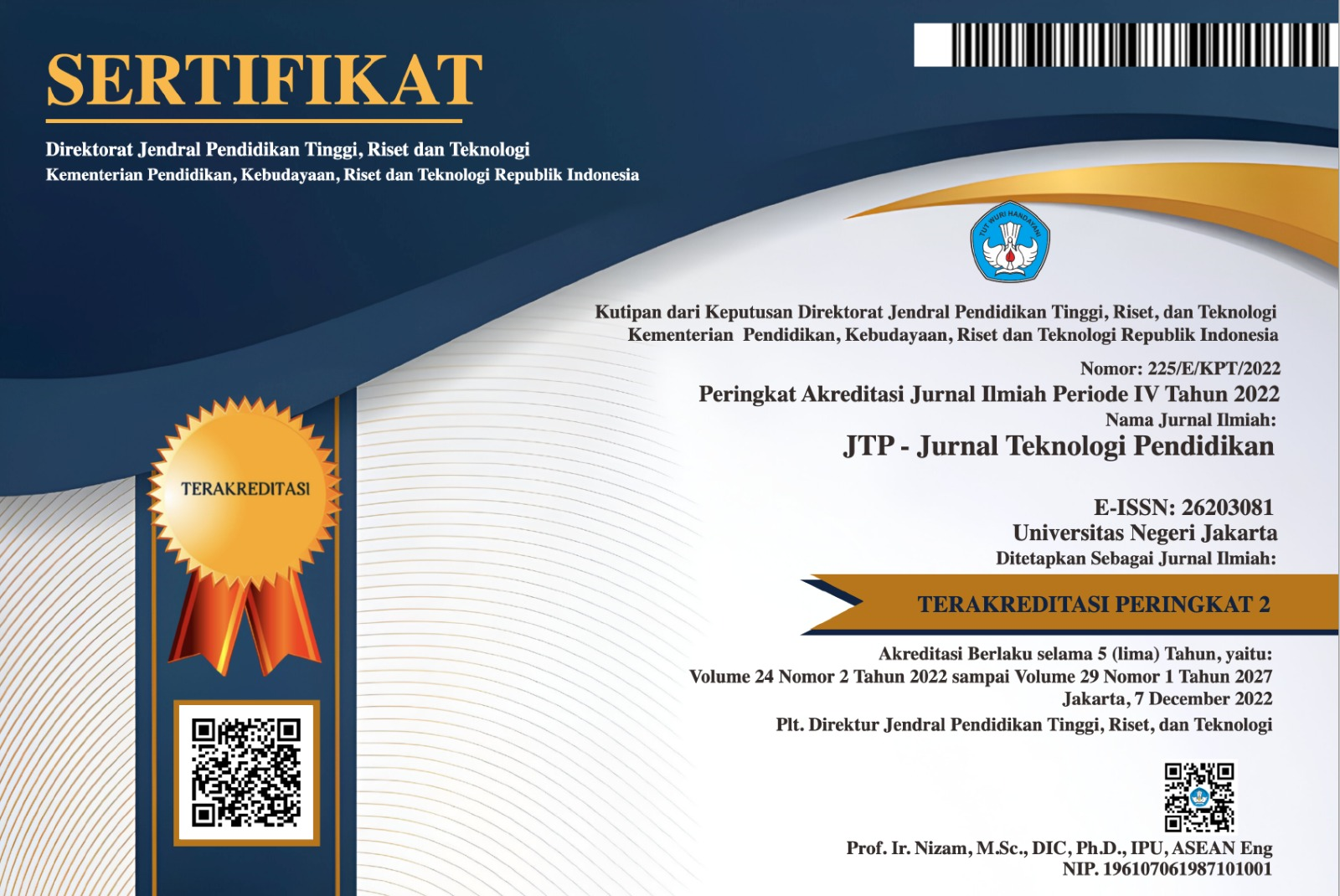Interactive Animation Learning Media on Android as a Creative Learning in Regression Analysis Topic
DOI:
https://doi.org/10.21009/jtp.v24i1.22567Keywords:
educational technology, interactive animation media, statistics, online learningAbstract
Technology has a significant role to build the quality of education which is one of the world’s purpose in sustainable development goals in 2015-2030 by United Nations. The implementation of technology in education is to develop the learning media. The purpose of this study is to create interactive animation learning media that can be accessed using Android Smartphone as one of creative learning alternative in online learning. This media was applied in Statistics Subject, Regression Analysis Topic, Accounting Department of Politeknik Negeri Bali. The method used in this research was research and development (R&D). There were some steps in this research which are (1) planning and designing; (2) production and editing; (3) validating and revision; (4) implementation; and (5) evaluation step. The first step was planning and designing. In this step, the animation characters, background, color theme, and storyboard were determined. The next step was production and editing step. After that the validation steps were done. There were three validators in this research, which were Statistics Expert, Statistics Lecturer, and Media expert. The validation score of this media was 95.33 that was classified as a very good learning media and proper to be implemented. The next step was revising step as the validators’ suggestion. The learning media then was implemented in experiment class using hybrid learning environment. And as the last step, the evaluation step was done by comparing the analysis test score of experiment class and the control class. The method used in evaluation step was two independent sample t-test. As conclusion, this media can improve the ability of student in Statistical Analysis.
References
Amiti, F. (2020). Synchronous and Asynchronous E-Learning. European Journal of Open Education and E-learning Studies, 5(2), 60-70.
Arsyad, A. (2014). Media Pembelajaran. Jakarta: PT Raja Grafindo Persada.
Boeren, E. (2019). Understanding Sustainable Development Goal (SDG) 4 on “quality education” from micro, meso and macro perspectives. International Review of Education.
Bustanil, M., Asrowi, & Ardianto, D. (2019). Pengembangan Media Pembelajaran Interaktif Berbasis Video Tutorial Di Sekolah Menengah Kejuruan. Jurnal Teknologi Pendidikan, 119-134.
Castells, M. (2004). The Network Society, A Cross-Cultural Perspective. Massachusetts: Edward Elgar.
Clark, Dublin, Gottfredson, C., Horton, B., Mosher, B., & Parks, E. (2007). The eLearning Guild’s Handbook on Synchronous e-Learning. Santa Rosa:: David Holcombe, eLearning Guild.
Daryanto. (2013). Media Pembelajaran: Peranannya Sangat Penting dalam Mencapai Tujuan Pembelajaran. Yogyakarta: Gava Media.
Delacey, B., & Leonard, D. (2002). Case Study on Technology and Distance in Education at The Harvard Bussiness School. Educational Technology and Society, 13-28.
El-Gayar, O., & Dennis, T. (2005). Effectiveness of Hybrid Learning Environments. Issues in Information Systems, 176-182.
Ferawati. (2011). Model Pembelajaran Multimedia Interaktif untuk Meningkatkan Penguasaan Konsep dan Keterampilan Generik Sains Guru Fisika pada Topik Fluida Dinamis. Prosiding Penelitian Bidang Ilmu Eksakta.
Fitriani, F., Parmin, & and Akhlis, A. (2013). Pengembangan Media Pembelajaran IPA Terpadu Berbasis Komputer pada Tema Bunyi Melalui Lesson Study untuk Kelas VIII. Unnes Science Education Journal, 1-10.
Gan, B., Menkhoff, T., & Smith, R. (2015). Enhancing students’ learning process through interactive digital media: New opportunities for collaborative learning. Computers in Human Behavior, 652-663.
Hediansah, D., & Surjono, H. (2020). Hybrid Learning Development to Improve Teacher Learning Management. Jurnal Kajian Teknologi Pendidikan, 1-9.
Indarto, P., Fatoni, M., & Nurhidayat. (2018). Model Pembelajaran Hybrid Learning pada Mata Kuliah Sepakbola di Pendidikan Olahraga FKIP UMS. Journal of Sport, Science and Education, 69-75.
Kauffman, D. (2004). elf-regulated Learning in Web-Based Environments: Instructional Tools Designed to Facilitate Cognitive Strategy Use, Metacognitive Processing, and Motivational Beliefs. Journal of Educational Computing Research, 139-161.
Khan, B. (2006). Flexible Learning in an Information Society. USA: Information Science Publishing.
Lee, H., Lim, K., & Grabowski. (2008). Generative Learning: Principles and Implications for Making Meaning. New York: Taylor & Francis Group.
Lord, G., & Lomicka, L. (2008). Blended Learning in Teacher Education: An Investigation of Classroom Community Across Media. Contemporary Issues in Technology and Teacher Education, 158-174.
Mc Kann, B. (2014). Utilizing Interactive Media Layering (IML) to Enhance Science Teacher Learning. Journal of Continuing Higher Education, 122-127.
Melton, B., Helen, G., & and Joanne, C. (2009). Achievement and Satisfaction in Blended Learning Traditional General Health Course Designs. International Journal for The Scholarship of Teaching and Learning, 1-13.
Moedjiono, S., Nurcahyadi, & Kusdaryono, A. (2018). Media Interactive Learning and biology subjects implementation with augmented reality application. Proceedings of the 2nd International Conference on Informatics and Computing (pp. 1-6). ICIC.
Munir, M. (2013). Multimedia Konsep dan Aplikasi dalam Pendidikan. Bandung: Alfabeta.
Nasional, K. P. (2003). Undang-Undang Republik Indonesia nomor 20 Tahun 2003 tentang Sistem Pendidikan Nasional,. Jakarta: Pemerintah Republik Indonesia.
Nation, U. (2015). Ensure Inclusive and Equitable Quality Education and Promote Life Long Learning Opportunities for All. Retrieved February 26, 2021, from Department of Economic and Social Affairs The 17 Goals: https://sdgs.un.org/goals/
Perveen, A. (2016). Synchronous and Asynchronous E-Language Learning: A Case Study of Virtual Uniersityof Pakistan. Open Praxis, 21-39.
Prastika, L. (2015). Pengaruh Penggunaan Multimedia Interaktif Berbasis Komputer Model Instructional Games terhadap Peningkatan Prestasi Belajar Siswa pada Mata Pelajaran Fisika. Prosiding Simposium Nasional InoPasi Pembelajaran dan Sains. Bandung.
Puadi, E. (2020). Analisis Sikap Siswa Terhadap Multimedia Pembelajaran Matematika Berbasis ICT dengan Model Computer Assisted Instruction (CAI). Journal of Research Mathematics Education, 1-11.
Putra, I. (2015). Orientasi Hybrid Learning Melalui Model Hybrid Learning dengan Bantuan Multimedia Di Dalam Kegiatan Pembelajaran. Eduscope, 36-42.
Ross, A., & Wilson, V. (2017). Independent Sample T-Test. In: Basic and Advanced Statistical Tests. Rotterdam: Sense Publisher.
Shahabadi, M., & Uplane, M. (2015). Synchronous and asynchronous e-learning styles and academic performance of e-learners. Procedia - Social and Behavioral Sciences, 129-138.
Smaldino, D., Deborah, L., & James. (2011). Instructional Technology and Media for Learning. Jakarta: Kencana.
Stosic, L. (2015). The Importance of Educational Technology in Teaching. nternational Journal of Cognitive Research in Science, Engineering, and Education, 111-114.
Sudjana. (2000). Metode Statistika. Bandung: Tarsito.
Sulistriyani, D., Ramadhani, D., & Sabirin, F. (2021). Developing Serious Video Games for Data Communication. Jurnal Teknologi Pendidikan, 11-22.
Susanto, A. (2016). Teori Belajar & Pembelajaran. Jakarta: Prenademedia.
Syahrinsi, A., Susanti, L., & and Siahaan, S. (2021). Development of Multimedia Interactive Learning of Hydrosphere. Jurnal Teknologi Pendidikan, 1-10.
Wiyono, K. (2009). Model Pembelajaran Multimedia Interaktif Relativitas Khusus untuk Meningkatkan Keterampilan Berpikir Kritis Siswa SMA. Seminar Nasional Pendidikan. Palembang.
Yanti, M., Ikhsan, N., & Subaer. (2016). Development of Interactive Learning Media on Kinetic Gas Theory at SMAN 2 Takalar. Journal of Physics: Conference Series, 121-130.
Zaniah, R. (2016). Pengembangan Media Pembelajaran Berbasis Animasi dan SImulasi untuk Meningkatkan Hasil Belajar Siswa Pada Mata Pelajaran Insalasi Penerangan Listrik di SMKN 1 Sidoarjo. Jurnal Unesa, 515-522
Downloads
Published
How to Cite
Issue
Section
License
Jurnal Teknologi Pendidikan is an Open Access Journal. The authors who publish the manuscript in Jurnal Teknologi Pendidikan agree to the following terms.
Attribution-ShareAlike 4.0 International (CC BY-SA 4.0)
-
Attribution — You must give appropriate credit, provide a link to the license, and indicate if changes were made. You may do so in any reasonable manner, but not in any way that suggests the licensor endorses you or your use.
-
ShareAlike — If you remix, transform, or build upon the material, you must distribute your contributions under the same license as the original.
- No additional restrictions — You may not apply legal terms or technological measures that legally restrict others from doing anything the license permits.
Notices:
- You do not have to comply with the license for elements of the material in the public domain or where your use is permitted by an applicable exception or limitation.
- No warranties are given. The license may not give you all of the permissions necessary for your intended use. For example, other rights such as publicity, privacy, or moral rights may limit how you use the material.








